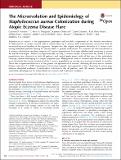Files in this item
The microevolution and epidemiology of Staphylococcus aureus colonization during atopic eczema disease flare
Item metadata
| dc.contributor.author | Harkins, Catriona P. | |
| dc.contributor.author | Pettigrew, Kerry A. | |
| dc.contributor.author | Oravcová, Katarina | |
| dc.contributor.author | Gardner, June | |
| dc.contributor.author | Hearn, R. M. Ross | |
| dc.contributor.author | Rice, Debbie | |
| dc.contributor.author | Mather, Alison E. | |
| dc.contributor.author | Parkhill, Julian | |
| dc.contributor.author | Brown, Sara J. | |
| dc.contributor.author | Proby, Charlotte M. | |
| dc.contributor.author | Holden, Matthew T. G. | |
| dc.date.accessioned | 2018-01-19T13:30:06Z | |
| dc.date.available | 2018-01-19T13:30:06Z | |
| dc.date.issued | 2018-02 | |
| dc.identifier | 251160165 | |
| dc.identifier | c30a1c5c-3f2c-4386-8583-9e4170f3b9a9 | |
| dc.identifier | 85041655628 | |
| dc.identifier | 000423029700017 | |
| dc.identifier.citation | Harkins , C P , Pettigrew , K A , Oravcová , K , Gardner , J , Hearn , R M R , Rice , D , Mather , A E , Parkhill , J , Brown , S J , Proby , C M & Holden , M T G 2018 , ' The microevolution and epidemiology of Staphylococcus aureus colonization during atopic eczema disease flare ' , Journal of Investigative Dermatology , vol. 138 , no. 2 , pp. 336-343 . https://doi.org/10.1016/j.jid.2017.09.023 | en |
| dc.identifier.issn | 0022-202X | |
| dc.identifier.other | RIS: urn:0CA68F82357F406CC5C910084C8E5EEA | |
| dc.identifier.other | ORCID: /0000-0002-4958-2166/work/60196473 | |
| dc.identifier.uri | https://hdl.handle.net/10023/12525 | |
| dc.description | Funding: Wellcome Trust [Grant number 104241/z/14/z] (CPH). Scottish Infection Research Network and Chief Scientist Office through the Scottish Healthcare Associated Infection Prevention Institute consortium funding [CSO Reference: SIRN10] (MTGH, KAP, KO). Bioinformatics and Computational Biology analyses were supported by the University of St Andrews Bioinformatics Unit that is funded by a Wellcome Trust ISSF award [grant 097831/Z/11/Z]. Wellcome Trust grant 098051 (JP, MTGH). Biotechnology and Biological Sciences Research Council grant BB/M014088/1 (AEM). Wellcome Trust Senior Research Fellowship in Clinical Science [106865/Z/15/Z] (SJB). | en |
| dc.description.abstract | Staphylococcus aureus is an opportunistic pathogen and variable component of the human microbiota. In atopic eczema (AE) a characteristic of the disease is colonization by S. aureus, with exacerbations associated with an increased bacterial burden of the organism. Despite this, the origins and genetic diversity of S. aureus colonizing individual patients during AE disease flares is poorly understood. To examine the micro-evolution of S. aureus colonization we have deep-sequenced S. aureus populations from nine children with moderate to severe AE, and 18 non-atopic children asymptomatically carrying S. aureus nasally. Colonization by clonal S. aureus populations was observed in both AE cases and controls, with all but one of the individuals containing colonies belonging to a single sequence type. Phylogenetic analysis revealed that disease flares were associated with the clonal expansion of the S. aureus population, occurring over a period of weeks to months. There was a significant difference in the genetic backgrounds of S. aureus colonizing AE patients versus controls (Fisher’s Exact test, p=0.03). Examination of intra-host genetic heterogeneity of the colonizing S. aureus populations identified evidence of within-host selection in the AE patients, with AE variants being potentially selectively advantageous for intracellular persistence and treatment resistance. | |
| dc.format.extent | 341798 | |
| dc.language.iso | eng | |
| dc.relation.ispartof | Journal of Investigative Dermatology | en |
| dc.subject | RL Dermatology | en |
| dc.subject | DAS | en |
| dc.subject | SDG 3 - Good Health and Well-being | en |
| dc.subject.lcc | RL | en |
| dc.title | The microevolution and epidemiology of Staphylococcus aureus colonization during atopic eczema disease flare | en |
| dc.type | Journal article | en |
| dc.contributor.sponsor | The Wellcome Trust | en |
| dc.contributor.institution | University of St Andrews. School of Medicine | en |
| dc.contributor.institution | University of St Andrews. Infection Group | en |
| dc.contributor.institution | University of St Andrews. Infection and Global Health Division | en |
| dc.contributor.institution | University of St Andrews. Biomedical Sciences Research Complex | en |
| dc.identifier.doi | https://doi.org/10.1016/j.jid.2017.09.023 | |
| dc.description.status | Peer reviewed | en |
| dc.identifier.grantnumber | 097831/z/11/z | en |
This item appears in the following Collection(s)
Items in the St Andrews Research Repository are protected by copyright, with all rights reserved, unless otherwise indicated.

